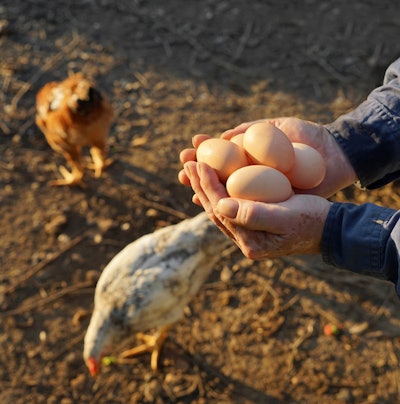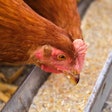
The effects of outdoor access on pasture-raised layer nutrition were discussed by Mike Banks, Ridley Feed Ingredients Poultry Specialist, at the 2022 Multi-State Poultry Feeding and Nutrition Conference and Danisco Animal Nutrition & Health’s Technical Symposium.
While cage-free eggs have become increasingly common due to state mandates and egg buyer purchase pledges, free-range and pasture-raised eggs have piqued the interest of some consumers.
Access to pasture exposes hens to vectors that barn raised birds are not exposed to like rodents, wild birds, pests and more. “We don’t know how to feed birds that have access to everything,” explained Banks.
When rearing pasture-raised birds, it is common for producers to rotate the pastures the hens are exposed to. “The empty pastures in the rotation are a great place for rodents or wild birds to set up,” said Banks.
Puddles that could potentially be harboring a disease organism are available for birds to drink from. Additionally, pasture-raised hens can be exposed to all of their flock mates, unlike cage housed hens, making disease control increasingly difficult.
“Is there a way that I can support their health through nutrition? I think as we get into the pasture raised sector, there is so much more that we can do as nutritionists to help veterinarians out,” Banks stated.
Lack of control
A common poultry management strategy known as FLAW (providing birds food, light, air and water) is negated when applied to pasture-raised birds, explained Banks. We have control over the feed. However, lighting is controlled by personnel on the farm and birds are exposed to outside air and water sources. Additionally, these birds have a higher level of activity, meaning they are burning more energy when compared to conventionally housed birds.
Its critical to place birds with the best genetic potential possible on pasture raised farms, explained Banks. Producers cannot be fully sure what the environment will be like due to the variables.
Certifications
Understanding the certifications of each producer, and the customer they are producing for, is important due to the varying standards. For example, certain certifications may not allow the use of a specific feed ingredient the producer uses at other farm locations.
Enzymes
Analyzing enzymes to be added into the feed ingredients the industry uses in large portions is financially important. We know that there are nutrients such as minerals and amino acids we can pull from these ingredients, said Banks. However, in some cases, such as the use of organic soybean meal, we need more research to confirm what enzymes will help birds utilize those nutrients better.
Diet formulation
The time spent reviewing production records for pasture-raised flocks while evaluating nutritional needs can be extensive due to the variability in environments, even though these flocks tend to be smaller than conventional or cage-free flocks. “These farms are smaller but need more attention compared to other birds,” Banks said.
Yolk color
In pasture-raised eggs, consumers expect to see a darker colored yolk because of outdoor foraging. However, if the environment lacks the components needed to change the yolk color, nutritionists will substitute those components with pigments in the feed, explained Banks. An additional issue arises when the birds are required to be fed organic approved pigments, increasing the cost further.
Egg size
Nutritionists are partially responsible for egg size, which affects case weights when packing, said Banks. Additionally, consumer preferences are focused on large and extra-large eggs. “If you have a flock that lays only large and extra-large eggs, you can go market. If you have a flock that lays organic medium eggs, there a good chance they will go to a breaker because there is no market for them right now,” explained Banks.
Making sure these birds who have expensive diets, pasture areas and bigger buildings lay a sellable egg through the help of nutrition is crucial, Banks concluded.


















